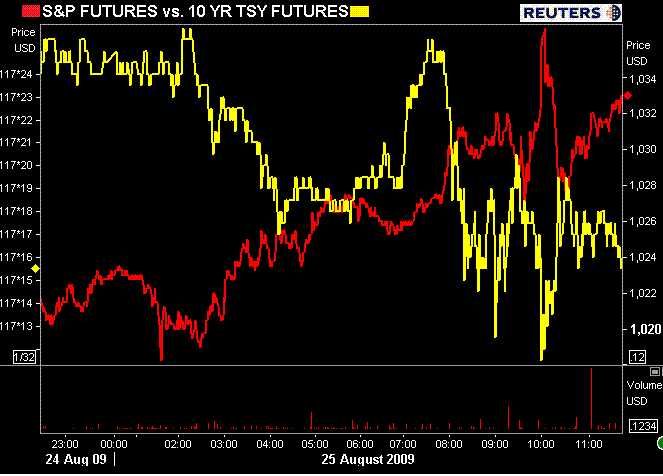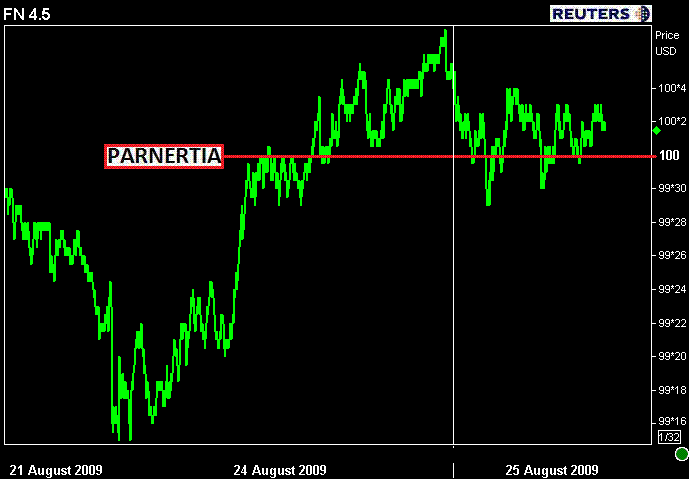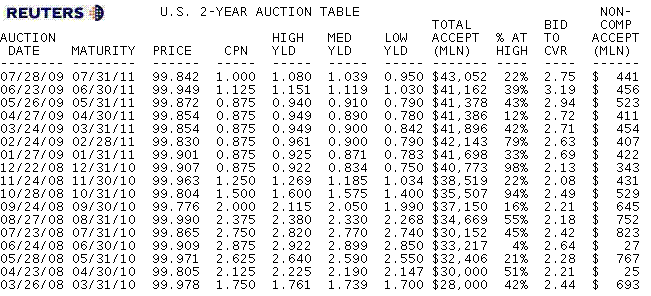The summer session is quietly coming to a close as school is back in session and parents are returning from last minute vacations. Although the pace of trading flows in financial markets has reflected the normal "slowness" that is expected to come in August...this quiet stillness has not been all that obvious on the surface. Interest rates have bounced around wide ranges while stocks have relentlessly rallied. Mortgage rates are down one day and up the next. Its been anything but "SLOW" on charts (I bet your pipelines are less busy though)...
That theme continues...
Check out how the S&P and 10 yr futures contract have behaved. A general uptrend in stocks with quite a bit of hesitation and a general downtrend in TSYs with quite a bit of anticipation...

Mortgages are no different...the FN 4.5 has chopped its way around 100-00 all morning.

A continued theme among readers seems to be frustration. Frustration about the way the markets react to news and economic data.
What the heck is going on in these markets?
The media has spent a great deal of time and energy attempting to connect financial market price fluctuations with fundamental headline news. Many actively participating readers seem to be hypnotized by the explanations offered up by talking heads. We must remind all: avoid attempts at rationalizing current financial market behavior with the media's perception of economic reality. The logic behind the equity markets relentlessly bullish bias is far more complex than the generally backward looking statistical observations and data collections of our government's finest economists.
Between October 08 and March 09, markets priced in their panicky reaction to the notion of systematic bank failures. Fortunately for us, the rapid reactions of the Federal Reserve and Treasury Department helped avoid the "worst case scenario" market participants had built into stock prices. Slowly, beginning in March as signs of stabilization began to emerge and panic dissipated, stocks started to recover the October-March five month selloff. Once the market began to believe that the worse case had been avoided, traders reclaimed the discount that was previously priced into stocks..bringing the S&P back to pre-October "STATUS QUO" levels...

Unfortunately,in the process... the "avoidance of the worst case" recovery rally in financial markets led to a major misinterpretation of economic reality. The trend of "BETTER THAN EXPECTEDS" created an unwarranted amount of economic optimism in headlines...something the media has focused on all summer.
Although we are willing to admit that a general slowing of the second derivative (pace of contraction) has played a role in the formation and continuance of the rally...in no way do we believe these fundamentals to be the strong foundation of an economic recovery. Even better...given the massive amount of inventory reduction and cost cutting that has occurred over the past year...there is definitely room for the perception of growth in the third and fourth quarter (THE SHORT TERM). Yes...it appears that the worst has been avoided...but does that mean we will witness a rapid recovery or is this just short lived optimism?
WHO REALLY KNOWS...basing long term outlooks on current data is essentially impossible given the view is muddled with multiple variables and a wide variety of assumptions. We do know this though..consumers are the fuel that fires our economic engines. This industry is upfront and personal with the health of the consumer on a daily basis. What do you think...are consumers ready to lead this recovery?
We say no. Most are more likely to be net savers vs. spenders as they rebuild lost wealth and dried up and damaged credit. In the short run business cost cutting will help...but we have some serious hurdles to get over in the long run.
Plain and Simple: Fundamentals have helped restore status quo. Fundamentals have provided a feeling that the worst of the storm is behind us. But fundamentals are unable to tell us anything about our long term prospects for growth...not yet at least, not with so many unknown economic inputs.
At the moment we are witnessing professional traders react to the short term perspective of the "big picture"...meaning the short term positivities combined with the momentum of trading flows outweigh the long term unknowns. This short term outlook has created a profitable opportunity for the market...and everyone has jumped on to ride the freight train...til its last stop!
This sentiment has become the basis for the misunderstood perception of an economic "RECOVERY". Dont get sucked into this read on reality.... keep telling yourself
It's a trader's world, we're just living in it.
It's a trader's world, we're just living in it.
It's a trader's world, we're just living in it.
It's a trader's world, we're just living in it.
It's a trader's world, we're just living in it.
Long term fundamentals are WEAK. Trading flows run far deeper than headlines...That is reality right now. Its all short term.
This perception of reality has had adverse effects on the the mortgage market. Interest rates have traded in a choppy range and yields have been volatile....something a pipeline manager dreads.
Managing interest rate and fall out risk in this marketplace can be a expensive if not handled appropriately. All a manager can do is set protective positions...then read and react to market flows. Unfortunately this is inefficient and at times costly. The broad effect over the mortgage market has been range bound rate sheets. Notice how lenders are always willing to reprice for the worse faster than for the better? Notice that sometimes you just dont get the rebate you were expecting?
If a lender publishes par rates at 5.00% and "rate sheet influential" MBS prices move lower...anyone who locked at 5.00% could cost the lender money as prices are now below where they locked (TBA MBS helps with this risk). On the other hand, if par mortgage rates move to 5.125% and MBS rally....borrowers would expect rates to fall. Anyone who locked in at 5.125% would be asking "why dont I get for the lower rate?!?"....leaving the lender with the potential for fall out and added hedging costs. (Fall out is generally same as warehouse risk). Volatility does not bode well for a pipeline hedger....nor does it help lower mortgage rates.
That said...the economic unknowns are not going to clear up in the near future...so wouldnt it make sense for the short term technicals to continue to outweigh long term fundamentals?
If that makes sense to you...its seems like the appropriate outlook is that short term technical reactions will likely continue to lead to choppy price action and volatile ranges...not a great implication for the stability of rate sheets. Dont miss opportunities when they are presented.
Rate sheets are mostly unchanged to slightly worse.
Next possible ALERT event: The Treasury will action $42 billion 2 yr notes at 1pm..stay tuned for reactions.
Here is a look at previous auctions...






